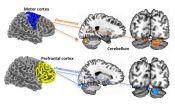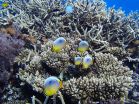(Press-News.org) WELLESLEY, Mass. - A new study by Heather Mattila, a leading honey bee ecologist and Assistant Professor of Biological Sciences at Wellesley College, published on April 8 in PLOS ONE, reveals that inadequate access to pollen during larval development has lifelong consequences for honey bees, leading not only to smaller workers and shorter lifespans, but also to impaired performance and productivity later in life. For the first time, this study demonstrates a crucial link between poor nutrition at a young age, and foraging and waggle dancing, the two most important activities that honey bees perform as providers for their colonies and as pollinators of human crops. The study was co-authored by Hailey Scofield, Wellesley Class of 2013, a former undergraduate research assistant who will begin a Ph. D program (in Neurobiology and Behavior) at Cornell University in Fall 2015.
The need to study nutritional stress in honey bees has grown pressing in recent years. In 2013, the U.S. Department of Agriculture and the Environmental Protection Agency named nutritional stress one of the top research priorities for understanding unexplained losses of honey bee colonies, a phenomenon known in the U.S. as Colony Collapse Disorder (CCD). With bee pollination accounting for over $15 billion in food crops and $150 million in honey annually in the United States alone, bee losses have enormous ecological and economic consequences. If bees vanish, many plants, including vital food crops like apples, almonds, berries and cucumbers, may also be at risk. Researchers believe there may be several interrelated factors contributing to bee decline, including nutritional stress, loss of foraging habitat, pesticides, pathogens, and parasites. These concerns prompted President Obama to form a Pollinator Health Task Force in 2014, an unprecedented action that named studies of the effect of poor nutrition on bees as one of its primary goals.
While a number of sophisticated nutrition studies have been undertaken recently, the Wellesley study is the first to show that nutritional deficits early in life can have far-reaching consequences for adult honey bees, including effects on complex behaviors like foraging and waggle dancing. "Nutritional stress has long been known to shorten bees' lifespan," stated Mattila, "but we've never had such a clear understanding of its impact on the tasks they perform, or known that its effects persist until their last days, even when bees have plentiful food as adults."
The study is also one of the few to be conducted entirely in a natural hive environment, which allowed larvae and adults to function in normal colonies, rather than in the incubators and cages that are more typical of nutrition studies. This unique methodology allowed Mattila, Scofield, and their undergraduate research assistants to observe the bees foraging and dancing in a natural context, activities they would not be able to perform in artificial lab conditions.
Foraging and waggle dancing are especially important to the health of a honey bee colony because they are the key means by which honey bees acquire food supplies like nectar and pollen, and communicate with other bees about the location of food sources and nest sites. When honey bee larvae were raised with a limited pollen supply, as might happen during periods of bad weather or as a consequence of habitat loss or commercial management practices, there were multiple negative consequences. The pollen-stressed bees were lighter and died younger, and fewer bees foraged. Those that did foraged earlier, for fewer days, and were more likely to die after just one day of foraging. Pollen-stressed workers were also less likely to waggle dance than workers that had been well-fed as larvae, and if they danced, the information they conveyed about the location of food sources was less precise. "Their dances were often visibly inconsistent and almost disoriented in the worst instances," said Scofield.
Importantly, nutritional stress interacts with a number of other stress factors, like pesticides and pathogens, which are already known to decrease longevity and impair foraging ability, creating a vicious cycle of poor health and population decline. Nutritional stress is also tied in part to a loss of foraging habitat, which can compound stresses from pesticide use and other commercial practices. Poor foraging and waggle dancing, in turn, could escalate bee decline if long-term pollen limitation if it prevents stressed foragers from providing sufficiently for developing workers. "If poor foraging habitats impose nutritional stress in colonies, then our study shows that the average stressed bee cannot compensate for reduced foraging opportunities by working harder to find food. This likely exacerbates nutritional stress and further limits the colony's ability to overcome food-finding challenges in areas that are no longer suitable for bees," explained Mattila.
The study also suggests that poor nutrition has the potential to undermine colony health and promote collapse. Conversely, ensuring that honey bees have access to diverse and plentiful forage throughout the year could mitigate the potential for collapse. "This means keeping bees in areas that are bee friendly, green, and full of flowering plants within the normal foraging radius of a colony, regularly checking colonies' food supplies, and providing supplements when natural forage is not available or colony stores are low," said Mattila. "Failure to provide these necessities may impose a legacy of dysfunction on colonies."
INFORMATION:
Research assistance was provided by Wellesley undergraduates Amanda Gardner, Rachel Reed, Catherine Oleskewicz, Anita Yau, and Amina Ziad. Additional funding was provided by the Essex County Beekeepers' Association of Massachusetts.
About Wellesley College
Since 1875, Wellesley College has been the preeminent liberal arts college for women. Known for its intellectual rigor and its remarkable track record for the cultivation of women leaders in every arena, Wellesley--only 12 miles from Boston--is home to some 2400 undergraduates from every state and 75 countries.
Photos and Interview Opportunities Available
Press Contacts:
Sofiya Cabalquinto, 781-283-3321, scabalqu@wellesley.edu
Anne Yu, Wellesley College, ayu@wellesley.edu, 781-283-3201
In early childhood, the neurons inside children's developing brains form connections between various regions of brain "real estate." As described in a paper published last week in the journal Biological Psychiatry, cognitive neuroscientists at San Diego State University found that in children and adolescents with autism spectrum disorder, the connections between the cerebral cortex and the cerebellum appear to be overdeveloped in sensorimotor regions of the brain. This overdevelopment appears to muscle in on brain "real estate" that in typically developing children is more ...
A single infusion of an experimental anti-HIV antibody called 3BNC117 resulted in significantly decreased HIV levels that persisted for as long as 28 days in HIV-infected individuals, according to Phase 1 clinical trial findings published online today in Nature. Major funding for the research was provided by the Bill and Melinda Gates Foundation, The Rockefeller University, and supported in part by the National Institute of Allergy and Infectious Diseases (NIAID), a component of the NIH. The research was led by long-time NIAID grantee Michel C. Nussenzweig, M.D., Ph.D., ...
The four collaborating organizations are the American College of Nurse-Midwives; the American College of Obstetricians and Gynecologists; the Association of Women's Health, Obstetric and Neonatal Nurses; and the Society for Maternal-Fetal Medicine. Additionally, these organizations partnered with VitalSmarts, a research and training organization.
The report, "Transforming Communication and Safety Culture in Intrapartum Care: A Multi-organization Blueprint," follows previous research on safety concerns during childbirth and communication among labor and delivery teams. ...
Washington, DC--Pesticide exposure, not obesity alone, can contribute to increased cardiovascular disease risk and inflammation in premenopausal women, according to a new study published in the Endocrine Society's Journal of Clinical Endocrinology & Metabolism.
The study looked at the effects of exposure to polychlorinated pesticides such as DDT. Although DDT was banned in many countries in the 1970s, it remains widespread in the environment and food supply.
DDT was one of the first recognized endocrine-disrupting chemicals, according to the introductory guide to endocrine-disrupting ...
A collaboration led by Shigeyuki Yokoyama of RIKEN and Takashi Kadowaki and Toshimasa Yamauchi of the University of Tokyo has used the SPring-8 synchrotron facility in Harima, Japan to elucidate the structure of two receptors of adiponectin, a protein that is associated with obesity and diabetes. The researchers hope that in the future this work, which was published in Nature today, will pave the way toward designing drugs that target these two receptors, AdipoR1 and AdipoR2, to reduce the early mortality associated with diabetes.
Adiponectin, a hormone secreted by fat ...
In the first results to emerge from HIV patient trials of a new generation of so-called broadly neutralizing antibodies, Rockefeller University researchers have found the experimental therapy can dramatically reduce the amount of virus present in a patient's blood. The work, reported this week in Nature, brings fresh optimism to the field of HIV immunotherapy and suggests new strategies for fighting or even preventing HIV infection.
In a person infected with HIV, there is an ongoing arms race between the virus and the body's immune system. Even as the body produces new ...
In a feat that would have been unachievable only a few years ago, researchers at UC San Francisco have pulled aside the curtain on a protein informally known as the "wasabi receptor," revealing at near-atomic resolution structures that could be targeted with anti-inflammatory pain drugs.
Officially named TRPA1 (pronounced "trip A1"), the newly visualized protein resides in the cellular membrane of sensory nerve cells. It detects certain chemical agents originating outside our bodies--pungent irritants found in substances ranging from wasabi to tear gas--but is also triggered ...
A new scientific synthesis suggests a gradual, prolonged release of greenhouse gases from permafrost soils in Arctic and sub-Arctic regions, which may afford society more time to adapt to environmental changes, say scientists in an April 9 paper published in Nature.
"Twenty years ago there was very little research about the possible rate of permafrost carbon release," said co-author A. David McGuire, U.S. Geological Survey senior scientist and climate modeling expert with the Institute of Arctic Biology at the University of Alaska Fairbanks. "In 2011, we assembled an ...
Fish are the key ingredients in a new recipe to diagnose and restore degraded coral reef ecosystems, according to scientists from the Australian Institute of Marine Science, WCS, James Cook University, and other organizations in a new study in the journal Nature.
For overfished coral reef systems, restoring fish populations that perform key roles will in turn restore ecological functions critical to recovery. For moderately or lightly fished reefs, the recipe requires knowing which fish to catch, how many, and which to leave behind.
The authors assessed fish biomass ...
EVANSTON, Ill. --- A new approach to analyzing baseball-pitching biomechanics may one day give players more personalized feedback and help prevent elbow injuries.
In a computer simulation study of baseball pitching, Northwestern University biomedical engineers found that the strength of the elbow muscles of a baseball pitcher likely play a bigger role in injury risk and prevention than previously thought.
The motion analysis approach currently used in the baseball industry to provide athletes with injury-risk feedback is not sophisticated enough to estimate what an ...



